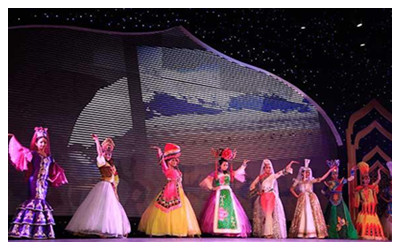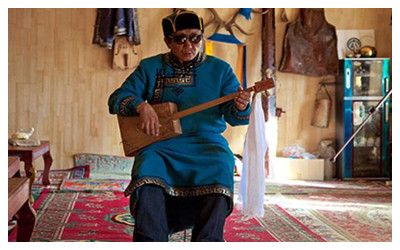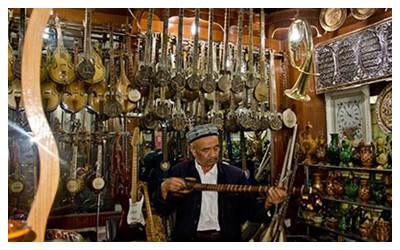Skype: neodalle-travel
Tel: +86 135 7447 2266
E-mail: sales@visitaroundchina.com
 Twelve Muqam
Twelve Muqam
It is a cultural legacy of the Uyghur musical tradition. It was developed over one and a half millennia ago,and finds it’s beginnings in the Arabic ‘Maqam’ melody system. It was created by an imperial concubine of the Yarkant Kingdom in the 16th century, and with the help of other musicians she travelled throughout different parts of Xinjiang to put together 12 compositions to carry forward and integrate many different Uyghur musical styles. The entire Muqam takes over 20 hours to perform. The “Twelve Muqam” is an epic narrative whose performance includes classical and folkloric song, music, and dance. It was designated by UNESCO as part of the Oral and Intangible Heritabe of Humanity.
 Sanam ( Beauty)
Sanam ( Beauty)
Another kind of Uygur music is called "Sanam," or "beauty," which involves singing and dancing to a group consisting of between seven to a dozen pieces of song-and-dance music. The music begins slowly and steadily, then picks up speed, and finally culminates in a climax of merry music and exuberant dances.
"Kuxak," "Eytixish," and "Maida"
These are spoken songs, which are common among the Uygur people. Accompanied by simple tunes, the speaker will talk his way through a song, usually about the love between a man and a woman. These songs can also be performed by two people.
 Uygur music is accompanied by a variety of instruments. Back in the Sui (581-618) and Tang (618-907) dynasties, the five-stringed pipa(a plucked string instrument with a fretted fingerboard) and konghou(harp, an ancient plucked stringed instrument) were popular in Qiuci and other areas. They arrived in the Central Plains along with music from the Western Region. The present Uygur music developed from ancient musical instruments from the Western Region as well as modern Chinese and foreign instruments; it includes dozens of stringed, wind and percussion instruments.
Uygur music is accompanied by a variety of instruments. Back in the Sui (581-618) and Tang (618-907) dynasties, the five-stringed pipa(a plucked string instrument with a fretted fingerboard) and konghou(harp, an ancient plucked stringed instrument) were popular in Qiuci and other areas. They arrived in the Central Plains along with music from the Western Region. The present Uygur music developed from ancient musical instruments from the Western Region as well as modern Chinese and foreign instruments; it includes dozens of stringed, wind and percussion instruments.
Pomegranate Blossom
This is a Uygur love song. It is about a young man who longs for his beloved girlfriend whom he describes as beautiful and soft as a flower blossom. The Tatars are another ethnic group in Xinjiang. The word "Tatar" used to refer to several powerful tribes in northern China about 1,100 years ago. The group has rich cultural traditions. Their music has lively rhythms, and their dances are cheerful. In the Tatar dance, men perform many leg movements, such as squatting, kicking and leaping, while women move their arms and waists. Tatars are known for their touching ballad songs.
Old Man's Song
It is an ancient folk song that describes an old man's sweet memories of the good old days and what he misses about his life when he was young and strong. The Uzbeks are another ethnic group in Xinjiang. Uzbeks can be found all over the region. Their lifestyles have had a strong influence on other ethnic groups such as the Uygurs and Kazakhs. But their traditional musical style has remained unchanged.Their marriage traditions have remained the same as well, as present-day Uzbeks continue to follow traditional marriage customs.
A marriage is achieved in three necessary steps: the marriage proposal, the exchange of betrothal gifts and the wedding ceremony. The first two steps are similar to those of other ethnic groups in Xinjiang. But Uzbek wedding ceremonies are unique. Before a wedding ceremony begins, the bride and groom's parents sit together with the matchmaker to negotiate "divorce compensation." The compensation refers to the amount of money the husband should pay his wife if he seeks a divorce after they marry. For Uzbeks, divorce is something shameful, while a happy marriage is considered the pride of both families.
The Girl with Dark Eyebrows
It is a traditional Uzbek folk song. It is a love song, but unlike most other love songs that are affectionate and sensual, this one is lively and full of humor. It depicts the witty conversation between a young couple with quickly changing rhythms and humorous words. It's played to the accompaniment of the "rewap," a unique plucked Uzbek instrument. The Kazakhs are one of the largest ethnic groups in Xinjiang with a population surpassing one million. They mainly live in the Ili Kazakh Autonomous Prefecture in northern Xinjiang.
Kazakh music and dance have their own unique features and are popular throughout China. Music is an important part of their way of life. During summer nights, Kazakhs often get together to party. They stay out during the entire night, singing and dancing. Their most popular musical instrument is the "donbra," a plucked two-stringed instrument popular in central Asia.
"Lark, Amazing Singer" is a well-known Kazakh song. It praises the beautiful singing of a lark, a bird that is beloved by Xinjiang residents. The song depicts people's passion for life and their homeland.
Come to this wonderful land! Beautiful nature, hospitable people, nice food, and merry festivals will give you an unforgettable experience. Every tourist can find an activity that he likes: alpinism, riding horses or camels, tasting exotic dishes, visiting historical attractions, taking photos, and having fun during holiday festivals.
 Ask Questions ?
Ask Questions ?